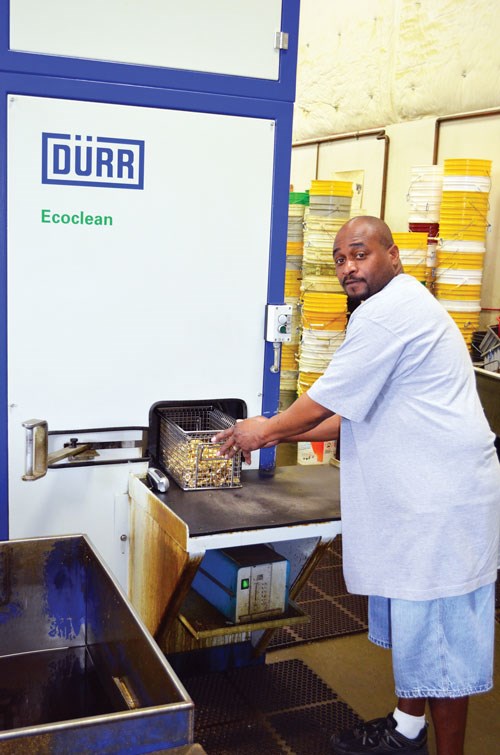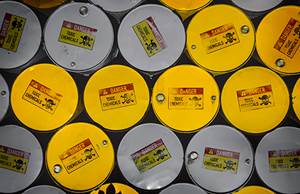Power in Compact Cleaning
Capital improvement decisions can often be “no risk/no reward.” This shop passed on potential production equipment in favor of a new cleaning system and found great reward.
For any shop, investing in major capital improvements, including new production, logistics or after-production equipment, is always a potential risk. Despite painstaking research, a company often can’t be fully sure about the decision it has made until well after the equipment is installed and integrated into its plant operations.
A new parts cleaning system is one of these major capital investments. The management team at Northwest Automatics Inc., in Kent, Wash. (near Seattle), was researching parts cleaning systems several years back. Gary Olsen, operations manager at the company, breaks these types of purchases down into three general categories: “Yeah, that was a decent purchase,” “Maybe that wasn’t such a good idea,” and “I should have done this 10 years ago.” He says the company’s purchase of the Dürr Ecoclean Minio 85C falls into the last of these categories.
Diverse Materials
Northwest Automatics is a machine shop occupying three buildings of 10,000 square feet each. The company produces high quality machined components with a number of multi-spindles, Swiss and CNC lathes and mills. The shop has been in business for about 15 years, working with various materials producing a variety of products, from threaded fasteners to fittings for a range of industries. Brass sensor housings, for example, are produced for the Seattle area’s aerospace industries. While brass products are the main focus, the company also machines products from all grades of steel, alloy and stainless steels, as well as some plastics. It is a competitive job shop, considering no job too small or too complicated. It is open to taking all types of projects in a range of industries such as trucking, agriculture, medical, defense and recreation, to name a few.
As a number of the company’s products are designed for Seattle’s defense and aerospace industries, the exacting nature of those industries means the components that Northwest Automatics produces must meet the very close tolerances demanded. For this reason, the parts cleaning system must ensure that machined components also meet the stringent requirements for cleanliness and readiness for further manufacturing.
Narrowing Options
The company formerly had a vapor degreasing system in one of its shops. The system worked fairly well, but used some potentially hazardous chemicals such as trichloroethylene, the use of which is now severely restricted. As the company moved into its new premises, it also sought a more efficient way to clean parts, as it had a constant backlog of numerous 5-gallon buckets waiting to go through cleaning. Previously, two people worked about 8 hours a day on parts cleaning.
The management team looked extensively for parts cleaning systems that would help get better results in the parts cleaning processes while saving labor and other costs. They decided against aqueous systems, which have many tanks and reservoirs with fluids that must be replaced often, resulting in disposal issues. Furthermore, a lot of parts machined by Northwest Automatics have deep blind holes. The management team found that the aqueous systems had trouble removing the grind slurry from the blind holes and, thus, did not satisfactorily meet the cleaning specifications.
Coming up empty in its search for a sufficient parts cleaning system, the team noticed that most that it investigated didn’t really save much labor or time. Throughput times seemed too long, and many required manual racking of parts as opposed to the ability to clean parts in open baskets. Many also had large amounts of fluids that had to be disposed of frequently.
The Decision
While at the Precision Machining Technology Show (PMTS) in 2005, Mr. Olsen visited the Dürr Ecoclean booth to see more parts cleaning systems. Intrigued by the systems on display, he threw every parts cleaning question in the book at Dürr’s sales rep, Fred Thompson.
The Northwest Automatics team was doubtful about the sales hype, and therefore shipped a pallet of dirtier than usual test parts to Dürr Ecoclean’s Michigan facility. Mr. Olsen watched the cleaning and drying process in person and was impressed by how effectively it cleaned and dried the parts. “Rather than take the salesman’s word,” Mr. Olsen says. “I wanted to see with my own eyes if it could do what they said it could. And it definitely was able to. Once testing proved its capabilities, we knew we had found the system we wanted.”
Northwest Automatics chose the Dürr Ecoclean Minio 85C, a smaller system available from Dürr Ecoclean, because research showed that it was the right size for the shop’s capacity. With a small footprint—1 meter wide by a little more than 2 meters deep (about 39 inches by 87 inches)—the Minio 85C can work well both for small facilities with comparatively low production and large-scale plants with decentralized cleaning stations.
The Minio 85C delivers degreasing and cleaning results with non-halogenated hydrocarbons through high-power injection flood washing and circulation filtration. The entire multi-stage cleaning process (cleaning, rinsing, vapor degreasing and vacuum drying), takes place in a single work chamber under vacuum. This process saves heating energy and minimizes vapor loss. Its throughput of about nine batches per hour (depending on the work sequence and required treatment time) met Northwest’s requirements for cleaning efficiency as well as a reduced labor investment.
The company also selected the optional ultrasonic cleaning feature. It has been a worthwhile option in terms of reaching the necessary level of deep cleaning, particularly with releasing machining oils and chips from the blind holes that are machined. Although it offers powerful cleaning, degreasing and removal of swarf and chips, the Minio 85C still allows easy customization of its eight washing programs through the Siemens S7 control.
Meeting Requirements
After it was installed, the cleaning system quickly tackled the backlog of parts to be cleaned at Northwest Automatics. Now, one person works on parts cleaning for only 4 hours a day (as compared with about 16 person-hours per day previously), and the cleaning system keeps up with the output. The company is able to stay ahead of production with less time invested, and the parts are better cleaned than they had been before. That’s a winning combination overall.
Northwest Automatics also has been pleased with all elements of the service from Dürr Ecoclean. The cleaning system was delivered promptly after being ordered, and setup and training were smooth and thorough. The system has performed very reliably since Day 1. Mr. Olsen points out that he can count on one hand the number of times he had to call the manufacturer for troubleshooting or to have a technician come in and do something that couldn’t be handled in-house. “Not only are the systems reliable, but our personnel have been trained well enough to be able to troubleshoot any technical operating issues that have come up,” he says.
An unforeseen side benefit has been the use of the Minio 85C for cleaning tooling and accessories. The company has a lot of collets, collet pads and bushings for the Swiss lathes, for example, which get quite dirty over the course of machining runs. These need to be cleaned before they can be used for the next run. Rather than cleaning them manually—a labor-intensive process by any estimation—operators simply run them in the cleaning system, saving significant setup time.
About the Environment
Not only does the cleaning system help the shop keep its labor costs lower while cleaning machined parts to tight specifications, it does so in an environmentally sensitive manner. As evidence, when the EPA was recently in the shop looking at processes and machines, the agent was genuinely impressed that the system is entirely self-contained (nothing down the drain) and that it is a clean operation in terms of solvent disposal. Northwest Automatics only has to dispose of about one 55-gallon drum of solvent per year, even though it averages 1,000 to 1,500 loads before changing out the distillation tank. Mr. Olsen says, “The guy from the EPA was very impressed that such a system is available on the market.”
The Minio 85C’s waste and energy saving features, such as heat recovery throughout the entire process, can fit well for shops interested in “greening” their manufacturing processes.
Return on Investment
Although Northwest Automatics considered purchasing other production equipment instead of the Minio 85C, the features the cleaning system brings seemed to make it the best choice. Benefits such as time and labor savings, rejection-free parts cleaning, multi-purpose use in cleaning tooling, and environmental friendliness in terms of energy use and minimal solvent disposal have helped the system more than pay for itself in the 5 years since it was purchased.
“This is one of those big decisions we have not regretted making,” Mr. Olsen says. “We have seen savings in the amount of labor we have to put into parts cleaning and the quality of the cleaning has improved considerably as well. There is a night-and-day difference in the quality of cleaning. Our customers are happy with the cleaning results, and our platers are pleased. The parts no longer need additional cleaning before plating, going directly in with no additional prepping required.”
Northwest Automatics chose the parts cleaning system from Dürr Ecoclean because it delivered the necessary performance—parts cleaned to the highest specifications and labor savings in an environmentally friendly system. Mr. Olsen continues to be a big believer in the product, demonstrating the equipment to neighboring shops and talking it up at various trade shows and networking events.
Related Content
Parts Cleaning Sector Shifts Energy Toward Regulatory Changes
With changes in EPA regulations regarding the use of some popular cleaning fluids, cleaning suppliers and end users are readjusting business strategies and/or cleaning processes to meet new requirements.
Read More3 Common Filtration Questions Answered
Learn about the variety of filters for removing particulates from a cleaning fluid, how to determine cleaning fluid life and more.
Read MoreCool Clean’s Omega 1500 Provides Powerful, Portable Cleaning
PMTS 2023: By selecting the appropriate nozzle and making the necessary propellant pressure and temperature adjustments, the Omega 1500 can clean to a variety of surface cleanliness levels.
Read MoreSita’s CleanoSpector Measures Part Cleanliness
PMTS 2023: Handheld measuring device checks for cleanliness of parts to assure product quality as well as prior to follow-up processes.
Read MoreRead Next
Emerging Leaders Nominations Now Open
Here’s your chance to highlight a young person in your manufacturing business who is on the path to be a future leader moving your company forward.
Read MoreA Tooling Workshop Worth a Visit
Marubeni Citizen-Cincom’s tooling and accessory workshop offers a chance to learn more about ancillary devices that can boost machining efficiency and capability.
Read More
























